Gowns and Negligees for House Wear 1901
The proper dress for the appropriate occasion means much time, trouble, and expense saved, and, fortunately, this fact is being better understood every year by women who take pride in being well turned out and who at the same time have a little conscience as to the amount of money they spend upon clothes.
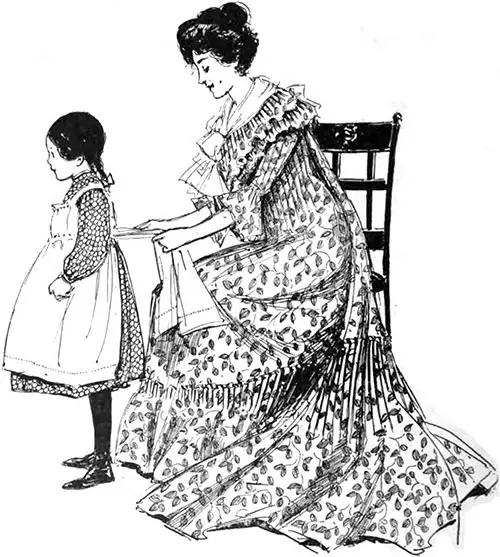
Flowered Red Silk Wrapper with Tucked Flopunce and Bertha; Fichu of Silk Mull.
There are one or two rules, strict ones, too, that have to be followed to carry out this scheme. The first and foremost is that specific gowns should not be worn excepting for the purposes for which they were initially designed.
The gown designed for street wear should never be worn in the house. There are hygienic as well as other reasons for this law.
To bring into a dainty boudoir or drawing-room the dirt and dust of the street, which in these days of long skirts it is impossible to avoid, is a most untidy habit. Moreover, to keep on the same shirtwaist that one has worn all day, or under a heavy jacket, is to feel uncomfortable and untidy, not to mention the wear and tear on clothes.
It is a mistake to accumulate too many clothes, but it is necessary to have gowns for the street and gowns for the house. These same gowns will last twice as long, and, better still, look smart until the last possible moment, if proper care is taken of them.
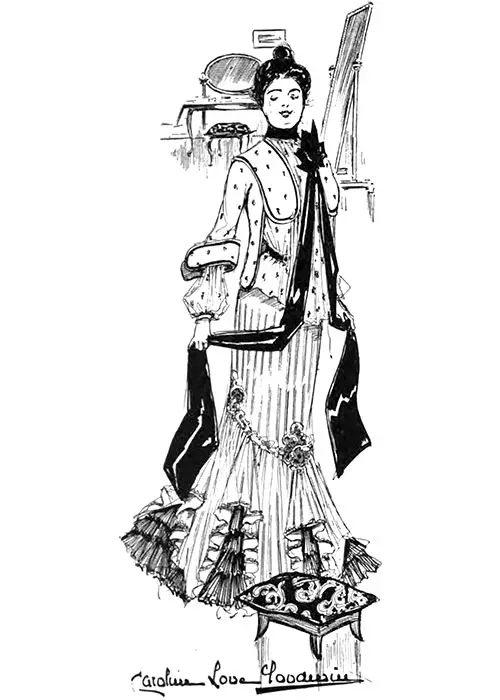
Matinee of Dotted cashmere with black velvet trimmings, over striped silk and chiffon skirt.
If the street gown is removed as soon as one enters the house, the skirt brushed and hung up, the shirtwaist turned inside out and left to air, and the jacket put away, it will last much longer than if the costume is kept on in the house for the rest of the day.
Another point in favor of house gowns as against street gowns is that our modern houses are so heated in winter that a much thinner style of clothing is necessary, and lighter-weight materials and lighter colors are most suitable, for there is no greater mistake than in choosing somber effects and fabrics with any weight for house wear.
Time was when the wrapper played such an essential part in the comic papers and was such an untidy garment that it was banished from any correct outfit, but the dainty wrappers of today and the pretty matinees make a charming style of morning dress and one that is comfortable and appropriate.
The kimono and such flowing garments should be relegated to the bedroom, but a pretty wrapper, with a fitted lining, may have loose fronts and a Watteau pleat in the back, and yet hot look in the least untidy or too negligee.
The crepons, cashmere, challies, and India silks are all good for these wrappers, especially in light colors. White is the smartest, of course, but soils too easily to make it practical for the majority of women.
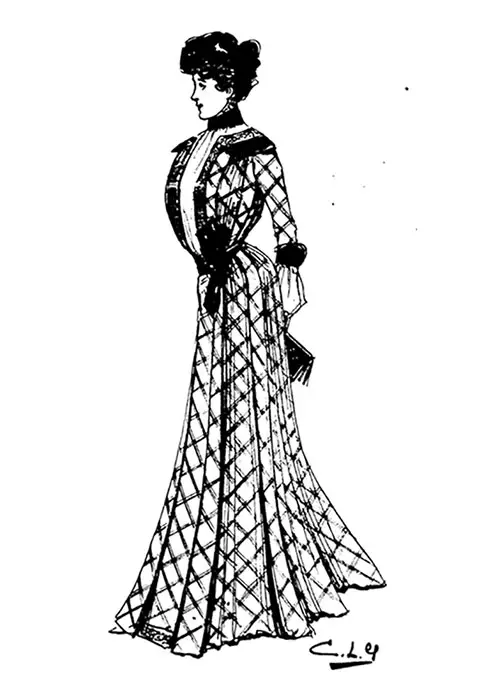
Morning House Gown of Plaid Wool with Silk Waistcoat and Velvet Revers, Cuffs, and Belt.
White lace should be used in trimming all wrappers, for so soon as it becomes in the least soiled it may be taken off and washed or cleaned, and in this way is a much better trimming than ribbon or chiffon, which rarely look the same after cleaning.
A matinee consisting of skirt and jacket is also a cute costume for the morning. The skirt is somewhat like a petticoat, not so full as a dress skirt, but finished with flounces and ruffles, and the jacket medium length, tight-fitting in the back and at the sides, and trimmed with ruffles and jabots of lace, a ribbon belt, from the aide, pulled down and tied in front in a point.
Many novelty goods make up well in this style of gown, but the thin silks are exceptionally pretty and can be made warm enough by an inner lining of thin flannel or albatross cloth.
A tea gown is not a proper costume for the morning, and while it is more or less on the plan of a wrapper, it must never be mistaken for it—that is, must never be made in a style that will be mistaken for it. The materials must be more luxurious and the trimming more elaborate.
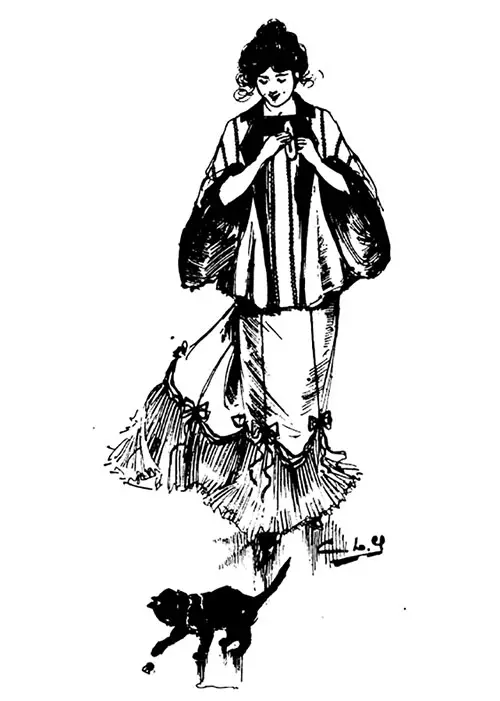
Dressing Sacque of White with Rose Stitching and Silk Trimming.
Tea gowns come under the head of house gowns but show no particular change in pattern from those that have been in style for the past few months. They are made in different colors and of every possible and some impossible materials.
These, while they are loose and flowing in effect, are fitted at the sides and back, and are most elaborately trimmed with lace and ribbons, or a jeweled collar and girdle. They are all made long, for a tea gown is supposed to be graceful.
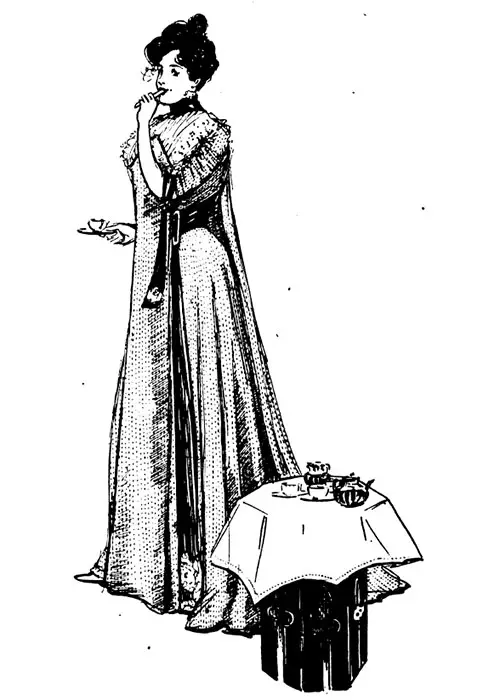
Tea Gown of Yellow Silk and White Lace, Trimmed with Scarf of Black Chiffon.
To sit down to breakfast in a brocaded tea gown would be entirely as incorrect as to wear a morning wrapper to receive one’s friends in the afternoon. These may all sound like mere trivialities, but they are the points that go for much in getting up a proper costume.
Too much care cannot be paid to the dressing of the feet, and the same rule that applies when wearing a street suit in the house applies equally to footwear.
Heavy stockings and boots should be removed when one enters one’s home, and a fancier stocking and light shoe or slipper be substituted. The favorite slipper at present is of kid or patent- leather with an extended vamp.
“Gowns and Negligees for House Wear,” in Harper’s Bazar: A Weekly Magazine for Women, New York: Harper & Brothers, Vol. XXXIV, No. 3, 19 January 1901, p. 164-166.
Editor's Note: Some terminology used in the description of women's clothing during the 1800s and early 1900s has been changed to reflect more modern terms. For example, a women's "Toilette" -- a form of costume or outfit has an entirely different common meaning in the 21st century. Typical terms applied to "toilette" include outfit, ensemble, or costume, depending on context.
Note: We have edited this text to correct grammatical errors and improve word choice to clarify the article for today’s readers. Changes made are typically minor, and we often left passive text “as is.” Those who need to quote the article directly should verify any changes by reviewing the original material.
